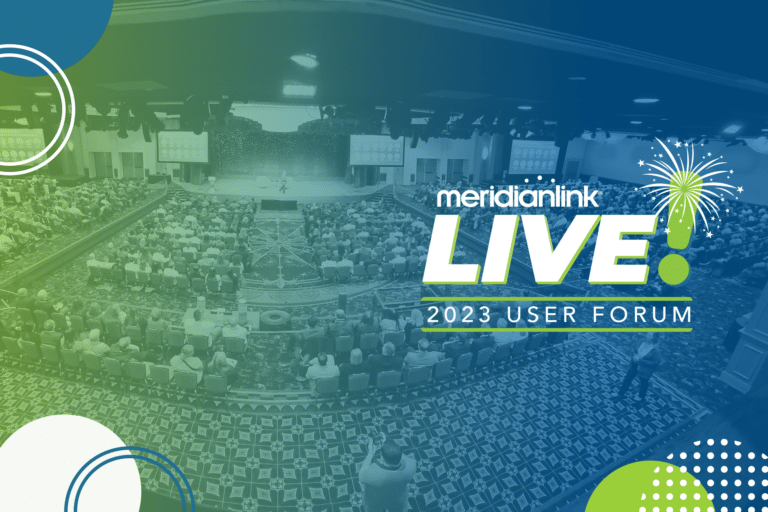The materials available in this article are for informational purposes only and not for the purpose of providing legal advice. You should contact your own advisors with questions regarding the content herein. The opinions expressed in this article are the opinions of the individual authors and may not reflect the opinions of MeridianLink, Inc.
Data Analytics Empowers Financial Institutions to Become Crucial Consumer Advisors
Trust is crucial when it comes to consumer relationships. In the digital age, where consumers have ample banking options just a Google search away, trust can be the deciding factor in whether they choose your financial institution (FI) or take their business elsewhere.
However, even though Forrester’s Financial Services Customer Trust Index reported a modest increase in consumer trust among U.S. banks, industry averages show that overall, trust in FIs is still weak. A lack of tools and support to help consumers during uncertainty, unoptimized technology, and security concerns are among the issues FIs commonly run up against that wear away at that trust, creating tedious and impersonal interactions.
So how can FIs build trust and create lasting consumer relationships? Alongside up-to-date technology and security measures, personalization is key—and creating personalized experiences requires tapping into your data with technology equipped to analyze it to create more targeted interactions.
Personalized Experiences & Data Analytics
Your FI’s data holds a wealth of insights into your consumers’ individual preferences, habits, and circumstances that are vital to providing relevant, tailored experiences and offerings. For example, alongside traditional demographics, you may want to include behavioral data—e.g., identifying which consumers use your mobile banking app vs. visit physical branches—or product and services data—e.g., identifying which consumers have taken out an auto loan with your FI in a given time frame—to help you better pinpoint your audiences to maximize outreach engagement.
And that engagement doesn’t only apply to products like checking accounts or loans. It can also apply to targeted financial advice and services aimed at helping consumers achieve their financial goals. Let’s look at an example to illustrate how this is done:
A Credit-Building Card Campaign
A bank wants to market a credit card designed to help consumers with bad or little credit history improve their credit. A mass marketing campaign for this card may see some results, but it’s likely that a significant portion of those receiving outreach about that card won’t be interested in or need the product, which will negatively impact engagement.
To avoid wasted marketing efforts and maximize engagement, the bank needs to turn to its data. With the right data analytics technology in place, the bank can pinpoint certain groups of consumers more likely to find value in this product: students and younger consumers with less credit history or consumers who’ve recently taken out a high-interest loan and/or had a guarantor on a loan—often indicating less-than-optimal credit history.
These consumer segments are much more likely to be interested in a credit-building card and would appreciate the thoughtful offer as a show of goodwill and genuine concern for their financial health—not to mention the heightened engagement the bank would see as a result of putting the offer in front of relevant audiences. It’s a win-win situation.
Becoming a Trusted Advisor
In the above example, not only does the bank optimize engagement, but it also fosters greater trust among consumers by demonstrating that it understands their specific needs and offers a product aimed at addressing those needs.
With that outreach, the bank has taken the first step toward positioning itself as a trusted advisor to its consumers, and now those consumers will be more likely to repeat business with the bank—reducing the risk of customer churn—and become promoters of it, sharing their positive experiences with others seeking a similarly tailored experience.
Your FI can also become an irreplaceable, trusted advisor to its consumers with the help of data analytics tools such as MeridianLink® Engage. By taking the extra step to identify each consumer’s specific needs via a deeper look at your FI’s data, you can get a clearer idea of their circumstances. From here, you can go beyond a simple transactional outreach and continuously deliver solutions aimed at helping those consumers succeed throughout their lives—whether it’s sharing your investment advisory services with somebody trying to save for retirement or including a frequent traveler in a campaign for a credit card with miles rewards to maximize savings.
And those outreaches add up—over time, your consumers will begin to expect your FI to have solutions, and they will automatically turn to you for assistance rather than shopping around at different FIs. In a world of almost endless choice, that’s a huge win and shows how personalization builds loyalty and trust.
Engagement Strategies & Considerations
It’s also important to consider the type of engagement strategies you use with different consumers. Targeted outreach sharing certain products can benefit specific consumers, but you should also weave other service offerings in where relevant, such as timely financial advice or services that could benefit consumers in the future based on their current trends, pulled from predictive data analytics.
Additionally, taking an omnichannel approach to outreach efforts across channels including social media, email, paid ads, and printed materials is helpful to maximize interactions. That’s because these different channels serve different, although sometimes overlapping, purposes, such as paid ads building brand awareness or emails reinforcing brand presence and nurturing relationships. This strategy ensures your FI touches consumers at every point in the customer journey.
Lastly, it’s crucial to also consider data security in creating these personalized communications. Of course, you need accurate, current consumer data to effectively reach your audiences, but you must be sure you’re protecting it every step of the way. Three ways to do this, as outlined by The Financial Brand, include:
- Building Trust & Transparency
Clearly explain data usage policies, create self-service portals in which consumers can manage their data, and offer customer support for more information
- Leveraging First-Party Data
Collect data at every consumer interaction point—email, social media, mobile app, etc.—to gain a comprehensive consumer overview. Opt-ins, registrations, and loyalty programs can also provide this data.
- Creating Value for Consumers
Deliver personalized experiences with genuine value to the consumer through a data-driven understanding of their needs, preferences, and circumstances. This helps lead to lasting relationships.
MeridianLink Can Help
MeridianLink Engage marketing automation solution and MeridianLink® Insight business intelligence tools can help your FI create data-driven, personalized interactions aimed at driving results and positioning your organization as a trusted advisor for your consumers at every point of their financial journey.
With seamless integration into most major core systems, these solutions help you better understand your consumers and deliver tailored outreach without putting additional strain on your team and resources.
Want To Learn More? Request a demo today or view our eBook Boosting Engagement Through Personalization for more tips.







